Complex, mysterious and currently incurable - the challenge for researchers working on neurodegenerative diseases is huge. We'll be finding out how scientists are using genetic approaches to understand these distressing illnesses. Plus we find out why claims of a male contraceptive pill are somewhat premature, discover how a 16th century mummy has revealed the history of hepatitis B, and investigate whether your genes could predispose you to life in orbit. And our gene of the month is the hollow-sounding Tinman.
In this episode
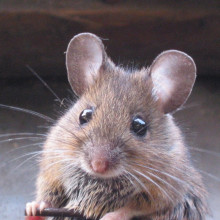
01:19 - Modelling neurodegeneration - Professor Lizzy Fisher
Modelling neurodegeneration - Professor Lizzy Fisher
with Professor Lizzy Fisher, University College London
Lizzy - Now one of the aspects of Down syndrome that's very interesting to study is that people with Down syndrome get the changes in the brain very, very early on that go with Alzheimer's disease, but they don't get the dementia until a couple of decades or so later at a greater propensity, a greater frequency, than in the rest of the population. But there's an interesting disconnect between having Down syndrome, why they get particular brain changes, and why the dementia occurs perhaps a couple of decades later.
Kat - So tell me a bit about this mouse model for Down syndrome. What exactly does it involve? How do you model a disease like that?
Lizzy - We took a human chromosome 21 out of a human cell - just from a normal cell that has been grown in culture for many years - and we transferred that into another type of cell line called an embryonic stem cell line, a mouse embryonic stem cell line. We can take these cells and inject them into very, very, very early embryo. So these are embryos that are so early that they're what we call pre-implantation - they wouldn't even have been implanted into the uterus yet.
We simply take those embryos and using the same techniques that you'd find in a human IVF clinic we re-implant those into recipient mothers, into foster mothers if you like, and then our embryos are born from that and a certain proportion of their cells will carry the human chromosome 21.
Kat - So what sort of features do you see in these mice?
Lizzy - So where we've looked, our mouse model does seem to recapitulate certain features of Down syndrome. So, one example is that we found very characteristic changes in learning and memory which appear to be similar to what we would find in people with Down syndrome. So for example, people with Down syndrome have certain differences from the rest of us in terms of laying down long term memories, and this appears to be the same in our mice as well. Similarly, 40% of babies who are born with Down syndrome have a very characteristic type of heart deficit and we're seeing exactly that same change in our mice as well.
Kat - And tell me a bit about these changes in the brain that look like Alzheimer's disease. What sort of thing do you think is going on there?
Lizzy - Alzheimer's disease is characterised by particular changes in the brain that are called plaques and tangles, and they're deposits of protein material that you don't find in normal brains, very, very characteristic of Alzheimer's disease. And the people with Down syndrome, they also have these deposits in the brain, probably rather earlier than the rest of us in the population. So, we would like to know why that is and also, what's the connection between those protein deposits and the appearance of dementia some decades later.
Kat - So are there any other issues with the brain development or the brain function in these Down syndrome model mice that you see?
Lizzy - Yes, there's one very interesting characteristic that we find and this is in the structure of the brain called the cerebellum. So this sits at the base of the brain near where the brain joins the spine. This structure is responsible for fine motor control. It does lots of things - it's also involved in what we call motor learning - and it's known that in people with Down syndrome, there's a particular set of cells, a particular very characteristic group of cells that don't really develop properly in this structure of the brain.
So we've gone back to have a look at our mouse model and sure enough, exactly the same cells have difficulty developing in our mouse model. So we know because Down syndrome is a genetic disorder, it arises from having an abnormal number of genes, we know that there must be a gene or genes in chromosome 21 that are responsible for that aspect of Down syndrome. We see exactly the same thing in our mouse and we can use mouse genetics to get to the individual genes responsible for that feature of the development of the human cerebellum.
Kat - You're also looking at mouse models of motor neuron disease. Is there anything particularly interesting you've seen in these mice?
Lizzy - Well, it's very early days for us with these mice but in the field generally, there's a lot of excitement because human geneticists found some new genes that are quite rare, but they are responsible for a small proportion of familial forms of motor neuron disease and it looks as if what these genes do is they're involved in processing of a chemical called RNA, and this is the chemical that moves between the DNA in the chromosomes, and sort of gives the instructions for how to make proteins.
And it turns out that there's a whole area of what we call RNA metabolism which is really the study of what happens to RNA in cells, what does RNA do? Because it turns out to have lots and lots of complex functions. And at least two and possibly more of the genes involved in motor neuron disease actually seem to be acting in RNA metabolism. So the field generally including us is now starting to work with mouse models and other models for example and now, in fruit flies to try to work out what's going wrong with RNA metabolism in motor neuron disease.
Kat - Have you started looking at the mice that you've got now to see if they have these problems?
Lizzy - We've started looking at one strain of mouse and we have a quite interesting finding for us which is that there's a type of processing of RNA which is called splicing - it's just cutting and pasting bits of RNA together - and we think that this is defective in one of our mouse models and so, this is something that we're going to follow up in the future.
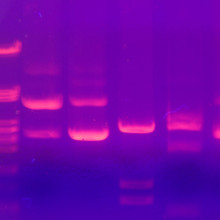
07:50 - Duplicate genes shaped brain evolution
Duplicate genes shaped brain evolution
with Safia Danovi
Safia - The first story that has caught my attention is a double in Cell led by two groups, the first by Evan Eichler and the second by Frank Polleux, and it's basically about what makes us human. They found a gene called SRGAP2 (very catchy) which was duplicated three times in humans and that seems to be what drove the expansion of our brains and led to the evolution of human culture.
Kat - Because this is a gene that's just been copied a few times in the genome and that does happen when things just slightly go awry when cells multiply.
Safia - It does, but you like to think that these small mistakes in evolution may be the difference between hair and auburn hair . But actually, it's quite sobering to think that it's a difference between man and mice.
Kat - Because it's the same protein in mice but it's just one single amino acid different. I find that incredible that maybe that is the difference between our brains and their brains.
Safia - Absolutely and it does beg the question, what on earth is this molecule doing in the brain and how is it functioning?
Kat - But we've had the human genome sequence for quite a few years now. Why didn't they spot this first time around?
Safia - Kat, I think the problem is really, that they didn't have technology that was sensitive enough to pick up small, minute differences. Anything like that was discarded as a mistake or harmless variation. I guess now we have access to high tech next generation deep sequencing which is revealing so much more that it's really beginning to tell us what makes us human, and this is information that the first human genome project missed.
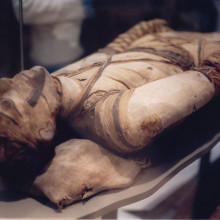
09:29 - Mummy provides virus clues
Mummy provides virus clues
with Safia Danovi
Kat - And I spotted a really nice story. They've looked at the mummy of a 16th century Korean child and manage to not only extract preserved organ tissue from its liver. They have actually managed to sequence hepatitis B virus from this child's liver from 500 years ago. This blows my mind.
Safia - I know and I actually - reading this, this was a study that was done by Israeli and Korean researchers, it was published in Hepatology. I couldn't believe how ancient this virus actually is. So, the authors estimate that the virus has its origin between 3,000 to 100,000 years ago which is incredible.
Kat - That's a pretty big margin of error though.
Safia - I know but it's stlll ancient. I mean, the other thing I hadn't realised what a significant health problem, hepatitis B was - there are 400 million carriers worldwide. And I guess what they're hoping is that the sequencing of this great ancient virus might offer some insights as to what makes the virus dangerous and where it might, how it might evolve in the future. The study used a sample from a boy who lived around the 16th century. It's just remarkable that they have access to technology that gives us such an insight into this boy's life. And actually, I really want to know more about the boy. I want to know how he died and how old he was, and makes me wonder what his life was like back then.
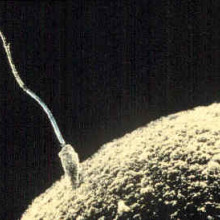
10:51 - Male contraceptive claims are premature
Male contraceptive claims are premature
with Safia Danovi
Kat - So moving from the 16th century to bang up to date modern times, there's some research published in PLoS Genetics this month from researchers up Edinburgh led by Lee Smith that led to headlines all over the place going "male contraceptive pill could be here, blah, blah, blah". But when you actually look at the research, that's really not what they found. What have these researchers been up to?
Safia - What they've done is they've identified a molecule called KATNAL1 which seems to be essential for sperm motility, so their ability to move within the testes as they mature. So I don't really know how this translated into a headline for male contraception but where I do think it could be really useful is in the future is developing it as a treatment for male infertility which can often occur as a result of low sperm motility, so this could be really one to watch.
Kat - I'm never convinced by any of the stories about the male contraceptive pill. I don't think I trust them, frankly. I think it is really interesting that they found this molecule and understood what it does, but I don't think it's anywhere else close to being something useful for contraception, but starting to understand infertility, that could be really important because it is something we don't really understand that much about.
Safia - It is something we don't understand and it's the cause of such distress for couples who are trying to have a baby and just can't. So hopefully, this might offer some important insight as to what is going wrong, in the cases where infertility is down to low motility in male sperm.
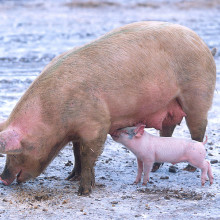
12:23 - Mmmm bacon... and genetics
Mmmm bacon... and genetics
with Safia Danovi
Kat - And finally, moving on to the genetics of bacon. You're a big bacon sandwich fan?
Safia - Actually, I have to confess. I'm a Muslim, so I've never tried the stuff, but it does smell awfully good.
Kat - Well that's interesting because this is a story led by Hiroaki Matsunami in the US and published in PLoS ONE about the genetics of why some people like the smell of pork or not. So previously, these guys had discovered that there's a receptor, a scent receptor, that means that if you have one version of it, you can smell a molecule called androstenone which is particularly produced by male pigs and makes meat smell very piggy basically. And if you don't have a functional copy of the gene, you can tolerate the scent much more because you can't smell it so much. So the researchers were approached by a Norwegian team, because in Europe there's currently discussion about whether castration for male pigs should be outlawed. Currently male pigs are castrated so that it's easier to keep them and farm them, but uncastrated male pigs make a lot of androstenone. They're very smelly, piggy animals. So they wanted to find out what would happen if there was actually a genetic impact and they did a little study that was looking at 13 people. Ten were professional smellers and three were just, I guess, regular people and found that people who had the copy of the gene that meant they could smell this androstenone, they've got a really powerful piggy scent, and I do think it's quite interesting that maybe our tastes and our taste perception may be much more under genetic control than we think.
Safia - Yeah, I completely agree and as the mother of a very fussy eater, this is really not great news for me, but I think it's also a really interesting interface between economics and genetics. So obviously the study was commissioned by the Norwegians because it might have very significant commercial applications if castration of male pigs is banned. It might mean that less people like meat and therefore, less people will want to eat pork.
Kat - It's interesting they speculate as well that maybe vegetarians are very sensitive to the unpleasant side of the smell of meat, so they're vegetarians for that reason. I do know some people who are really turned off the smell of meat and don't eat it.
Safia - Yeah and not just vegetarians. It would be really interesting to see whether these genes are present in populations that have not eaten pork for centuries and centuries, so Jewish communities, Muslim communities, Buddhist communities. It would be really interesting to see how many copies, if any of these genes are present in these people.
Kat - Certainly food for thought.
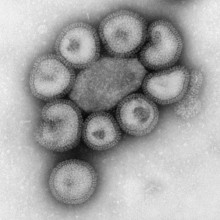
15:17 - Controversial flu research published
Controversial flu research published
Researchers have finally published a study in the journal Nature showing how so-called bird-flu (avian H5N1 influenza virus) can become contagious in mammals, after heated public debate and a controversial US government recommendation to block publication. The research reveals that only a few amino acid changes are required to convert the bird virus into one that can spread in mammals, with only four changes to the viral haemagglutinin protein needed to make it into a significant threat to humans.
The researchers, led by Yoshihiro Kawaoka in Wisconsin, believe that publishing their findings is essential to help scientists around the world develop ways to monitor the disease and find effective ways to halt a future pandemic. But others have argued that the information could be hijacked by bioterrorists trying to use flu viruses for nefarious purpos

16:07 - Tomato genome sequenced
Tomato genome sequenced
Genetically-inclined ketchup fans can rejoice this month, because the whole genome of the tomato - specifically the Heinz 1706 variety - has finally been sequenced and is published in the journal Nature.
Known to biologists as Solanum lycopersicum, the tomato's genome holds clues to how the plants could be bred to have improved yields and disease or drought resistance, as well as better taste and colour.
The researchers, from the international Tomato Genomics Consortium, discovered that the plant has around 35,000 genes distributed across 12 chromosomes.
Tomatoes are related to other fleshy fruits such as strawberries, apples, melons and bananas, so the information from their genomes could be useful for understanding more about some of the other juicy inhabitants of our fruit bowls.
16:54 - Turning the clock back on blood stem cells
Turning the clock back on blood stem cells
US and German researchers have managed to turn back the clock on blood stem cells, making them effectively younger, according to new results in the journal Cell Stem Cell from a team led by Dr Hartmut Geiger. The research overturns previous ideas suggesting that ageing of these cells - also known as haematopoietic stem cells - was genetically pre-programmed and unchangeable.
As we age, these stem cells become less effective at regenerating our blood and immune cells, helping to explain why older people are more susceptible to infections and other illnesses such as anaemia and cancer. The scientists discovered that this ageing process is controlled by a protein called Cdc42, and that blocking it could restore the properties of young blood stem cells to older ones. At the moment the research has only been done in mice, but the team is hopeful that one day they'll be able to turn back the clock in human blood stem cells.
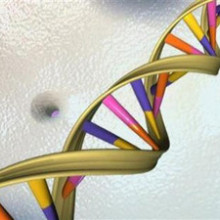
17:49 - Blood test to monitor genetic changes in cancer
Blood test to monitor genetic changes in cancer
Scientists at the Cancer Research UK Cambridge Research Institute have developed a simple blood test that could monitor the genetics changes in cancer as it grows and evolves within the body, publishing their results in Science Translational Medicine.
By analysing circulating tumour DNA - tiny fragments of DNA shed from cancer cells as they die - the researchers, led by Drs Nitzan Rosenfeld and James Brenton, showed that the test could be used to monitor the progress of cancer in response to treatment on a genetic level, including picking up new gene faults not present in the original tumour. Technology like this could prove very important as doctors move towards tailoring treatment according to the genetic makeup of a individual's tumour.

18:58 - Stem cells for studying neurodegeneration - Dr Kevin Eggan
Stem cells for studying neurodegeneration - Dr Kevin Eggan
with Dr Kevin Eggan, Harvard Stem Cell Institute
Kevin - It's sort of like rebooting the identity of a cell. What people discovered - and when I say people really, it's an interesting scientist in Japan named Shinya Yamanaka - He discovered that if you take skin cell and you force it to express a small group of genes that are at the heart of what make an embryonic stem cell an embryonic stem cell, you can convert those simple and lowly skin cells into the equivalent of an embryonic stem cell. And then we can use those induced pluripotent stem cells to make all the different cell types in the body and they're remarkable because they're sort of supercharged stem cells. They can grow forever in the tissue culture dish in the laboratory and they have the capacity to make all the different cell types in the body.
Kat - This sounds absolutely incredible - almost the stuff of science fiction! You can turn cells into any sort of cells you want. What are some of the applications of this sort of technology?
Kevin - Well, as I implied earlier, I would say that the application that people think the most about is that we would use these cells to replace those that are damaged in disease or through injury, and I think that's a very exciting area of research which is moving forward rapidly. The idea that we would make insulin producing cells from these stem cells and maybe administer them to diabetic patients or to produce transplants for people who have Parkinson's disease, there's a lot of excitement over that. Now, our own particular interest is actually in motor neuron disease as it's known here in the UK or amyotrophic lateral sclerosis, or Lou Gehrig's disease as it's known in the United States. And in this case, it's a very specific type of nerve cell which is dying, the nerve cells which connect our brains to our musculature, but unfortunately, those cells die all over the body. And so, it's difficult to think about transplanting all of these different nerve cells and having them reconnect appropriately.
So we take a different kind of approach. We've actually discovered a different sort of utility for those cells and it's really one that tries to leverage or take advantage of these remarkable new developments in human genetics that are unfolding today. And that it's that instead of making the cells which are lost in the disease to put them back, we're using them to understand why it is that they get sick in the first place and to try to stop them from getting sick or prevent the disease from progressing in people that have the disease.
And then what we've discovered is that even though people with motor neuron disease may not be outwardly sick until maybe they're in their 40s, 50s, 60s, there's probably something in many cases which is wrong with their so-called motor neurons from the very beginning. And we've been able to get some insight into those differences now and we think that there will be good opportunity for developing new drugs to stop the disease.
Kat - Do you think there might also be ways to identify people who would be at risk of developing this disease too?
Kevin - Yes, absolutely. So this is one thing that is interesting about motor neuron disease is that only a fraction of people who walk into the clinic with this disorder really are familiar with it because it's in their family. And so, one thing we're trying to discover is, in those people that don't have a clear familial history, is there some more complicated genetic makeup of them that makes them more susceptible to disease.
And by making their motor nerve cells and comparing them to individuals which have more clearly inherited forms, we're starting to get some insight into that and in fact, it does seem that at least some people with motor neuron disease have what I would call 'unappreciated heritability'. That is to say that there are disease genes running within them and they didn't necessarily appreciate it.
Kat - And you mentioned that there may be approaches for new treatments. What's in the pipeline?
Kevin - One important discovery that we've made using this type of system is that - which is quite surprising - is that other cell types in the nervous system begin to attack the motor neurons in this disease. That is to say that the problems that are going wrong in the disease aren't only limited to the nerve cells themselves but that other cells in the nervous system that are usually supportive of motor neurons seem to turn on them and attack them.
And we and others have been - over the last couple of years - very focused on the pathways which seem to be involved in this sort of motor neuron murder, this sort of terrorism against motor neurons in the nervous system, and we've been able to identify several compounds which seem to interrupt this toxic effect and at least are showing some promise in the animal models now. And so, I still think I'd caution that this is a way from clinical trials, but I think it's another new drug target which hasn't been appreciated for this disease that surely is going to be interrogated.
And in general, I would say, although motor neuron disease is devastating as all too many diseases are, and although it's a disease that for the time being, there aren't promising therapies, there are quite a lot of exciting developments in clinical development for motor neuron disease today. And so, I think there is a great deal of hope for patients for the future.
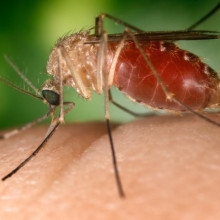
Could we breed a mosquito that doesn't carry diseases?
Answered by Dr Frank Jiggins, Dept of Genetics, Cambridge University.
Frank - It's actually quite straightforward to breed a mosquito that can't transmit malaria. So, if you go to natural populations, you'll find a mixture of mosquitoes in the same population, some of which are very good at transmitting say, malaria, or dengue fever, and others of which are much more resistant and can't transmit these diseases. So, it's quite straightforward to bring them into the laboratory and you can breed from the individuals which are resistant to these diseases and you end up with a population of mosquitoes that can't transmit the disease. So yes, people have done it and it works.

Are there genes that make people better suited to become astronauts?
Answered by Dr Frank Jiggins, Dept of Genetics, Cambridge University.
Frank - Certainly, astronauts suffer from all sorts of health problems and most medical conditions have some genetic component, so there's genetic variation amongst individuals as to how likely they are to develop these conditions. So at least in theory, you should be able to predict which individuals are likely to develop these conditions and they'd make the better astronauts. So for example, one of the problems is the effects of low gravity which can result in muscle wasting and reduced bone density, and we know from people on Earth that there's a lot of genetic variation in these traits. About 20 genetic variants have been identified that affect bone density. So you could maybe pick individuals which had the better genetic variants and maybe they'd be less likely to develop these conditions. Another problem that an astronaut might develop is space adaptation syndrome which is a type of motion sickness. This generally only affects about half of astronauts. So it's possible that maybe there's a genetic component there and if we could identify it, we might be able to predict those astronauts which would develop this problem.
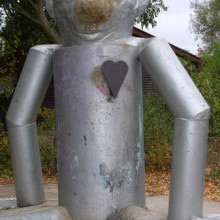
28:06 - Gene of the month - Tinman
Gene of the month - Tinman
with Kat Arney
And finally, our gene of the month is the hollow-sounding Tinman, whimsically named after the character in the Wizard of Oz who's rather lacking in the heart department. Tinman was first discovered in the late 1980s by Dr Rolf Bodmer, who discovered a gene that was particularly active in the tiny dorsal vessels of fruit flies - the insect equivalent of a heart. Unfortunate fruit fly embryos with a faulty version of the gene lack a dorsal vessel, and obviously don't get very far in life.
Over the following years, researchers discovered the mammalian version of the gene, which was given the rather less whimsical name of Nkx2-5. Mice lacking this gene in their heart cells have several problems including cardiomyopathy - problems with the heart muscle - and problems with keeping a regular heartbeat.
These symptoms are familiar to cardiologists dealing with families with a strong history of heart defects and sudden heart attacks at a young age, and in 2004, researchers discovered that these families are afflicted by inherited faults in the human version of Tinman. Scientists are now taking this discovery forwards by trying to develop drugs that target some of the molecular pathways that Tinman is involved in, which could help people with heart disease in the future.










Comments
Add a comment